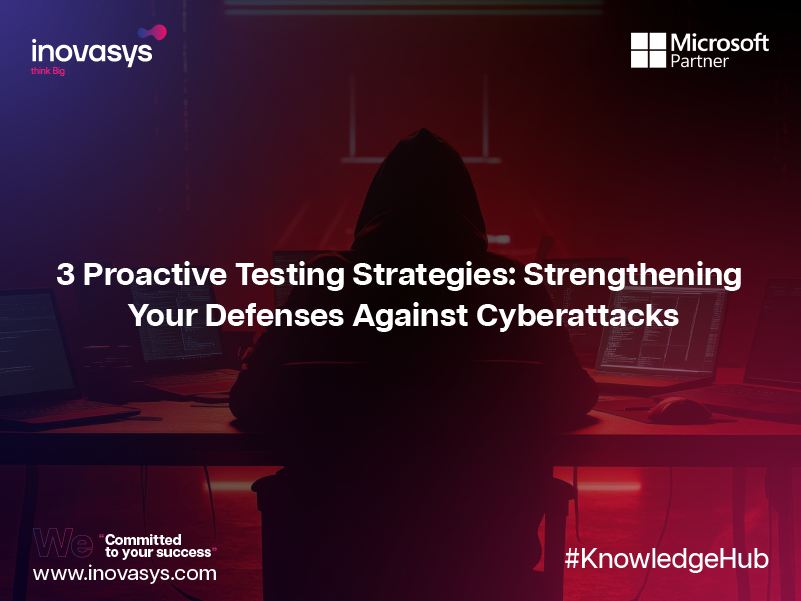Inovasys, founded in 2014, has been a leader in providing advanced technology solutions. By 2020, it became known as a service provider. The company aims to be the best partner for businesses looking to improve their operations with digital technology.
Articles & Press Release

3 Proactive Testing Strategies: Strengthening Your Defenses Against Cyberattacks
Proactive testing is a vital security methodology that empowers organizations to identify and ad-dress vulnerabilities before malicious actors can exploit them. This forward-thinking approach contrasts sharply with reactive measures, which only respond to breaches after they occur. For CISOs and security leaders, proactive strategies offer not just peace of mind, but strategic control over security posture and risk exposure.
Key Differences in Proactive Testing Methods
Several proactive testing strategies can be employed, each with unique strengths and strategic value. These include:
1. Vulnerability Scanning
Vulnerability scanning uses automated tools to detect known weaknesses in systems and appli-cations. It’s a fast, scalable, and cost-effective way to uncover common security gaps, but it may not identify complex or zero-day vulnerabilities. It is often considered a foundational step in con-tinuous risk assessment.
2. Penetration Testing (Pentesting)
Penetration testing simulates real-world attacks in a scoped and controlled manner. Ethical hack-ers exploit vulnerabilities to assess how an attacker might gain unauthorized access. Pentesting provides deep insights into exploitable weaknesses and evaluates the effectiveness of specific security controls.
3. Red Teaming
Red teaming goes far beyond traditional testing. It is a realistic, goal-oriented adversary simulation that mirrors the tactics, techniques, and procedures (TTPs) of advanced threat actors. Unlike pen-testing, which is overt and limited in scope, red teaming is stealthy, persistent, and designed to challenge not only technical defenses but also your organization’s detection and response capa-bilities.
Red Team exercises are tailored to achieve specific objectives—whether accessing sensitive da-ta, compromising executive communication, or evading detection—providing CISOs with a com-plete picture of organizational resilience.
Why Simulate Attacks? 5 Benefits of Simulated Attacks
Simulated attacks may seem counterintuitive, but they deliver strategic benefits, including:
1. Uncovering vulnerabilities that automated scans might overlook.
2. Providing a realistic, attacker’s perspective on your environment.
3. Stress-testing and refining incident response plans.
4. Evaluating the responsiveness and skill of security personnel.
5. Validating your organization's preparedness for high-stakes, real-world threats.
By integrating simulated attacks—especially through Red Team exercises—organizations gain ac-tionable intelligence to sharpen defenses and close security gaps before adversaries can exploit them.
The 3 Key Benefits of Proactive Testing
1. Security Posture Validation
Proactive testing validates the effectiveness of existing security measures. It uncovers misconfig-urations, unpatched vulnerabilities, and security gaps before they’re discovered by threat actors.
2. Incident Response Testing
Simulated attacks test your team's ability to detect, contain, and recover from cyber threats. Red teaming, in particular, assesses not just the technical controls but also communication, escala-tion, and decision-making processes across departments.
3. Compliance
Many industry regulations require organizations to perform regular security testing as part of their risk management programs. Proactive testing helps ensure alignment with these requirements, supporting audit readiness and demonstrating a commitment to safeguarding sensitive data.
Comparison of Proactive Testing Methods
Each proactive testing method plays a distinct role in a mature cybersecurity program. Vulnera-bility scanning is automated and low-cost, ideal for identifying known issues across large envi-ronments quickly and continuously. However, it may not detect more complex threats. Penetra-tion testing is a deeper, manual assessment where ethical hackers exploit vulnerabilities in a controlled scope to understand how an attacker might move through your environment. It offers more detailed insights than scanning but remains limited in duration and focus. Red teaming, on the other hand, provides the most comprehensive assessment by simulating real-world, persis-tent threats across technical and human layers. It’s stealthy, goal-driven, and designed to chal-lenge both preventative and detective controls, offering organizations a realistic view of how resil-ient they are under real attack conditions.
Why Proactive Testing Strategies Are Essential for Organizations
Implementing proactive testing strategies equips organizations to defend their digital assets with confidence. By simulating threats and stress-testing defenses before attackers strike, companies can:
• Preemptively remediate vulnerabilities
• Improve detection and response readiness
• Ensure alignment with regulatory expectations
• Demonstrate commitment to cybersecurity excellence
From routine scans to adversary emulation, these strategies ensure that your environment is ready for today’s ever-evolving threat landscape.
Frequently Asked Questions (FAQs)
1. What is the difference between pentesting and red teaming?
Penetration testing is scoped, time-boxed, and overt—designed to identify and exploit vulnerabili-ties. Red teaming is broader, stealthy, and goal-driven, focusing on emulating real-world adver-saries to challenge both technical and human defenses.
2. How often should organizations conduct proactive testing?
At minimum, organizations should conduct proactive testing annually and after significant infra-structure changes. Red teaming is typically done on a less frequent, strategic basis due to its scope and depth.
3. What role does threat intelligence play in proactive testing?
Threat intelligence enhances testing strategies by aligning simulations with current tactics and actor profiles, helping teams prepare for what’s most likely to target them.
4. Can proactive testing help with compliance?
Yes. Proactive testing supports compliance by meeting expectations for regular security valida-tion, reinforcing your organization’s commitment to risk mitigation and data protection.
Ready to See How an Attacker Thinks?
Partner with our Red Team for a customized, intelligence-led adversary simulation that challenges your defenses, tests your incident response, and reveals blind spots across your security infra-structure.
Let’s talk about how we can help you stay ahead of the threat.

